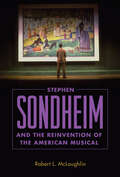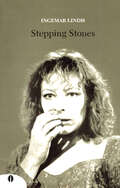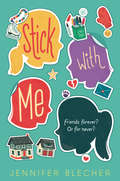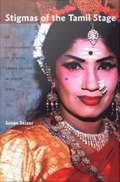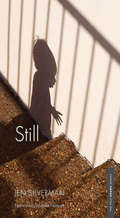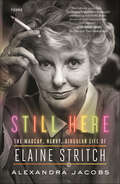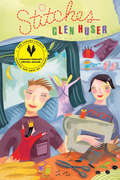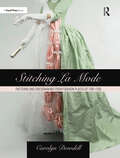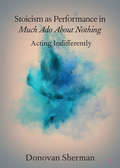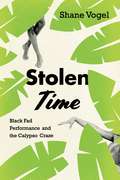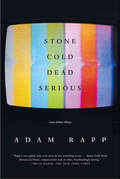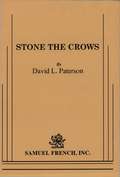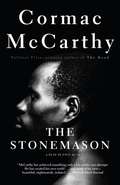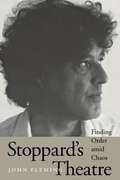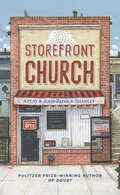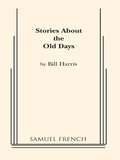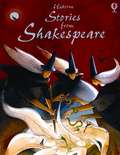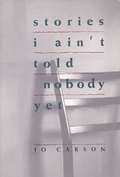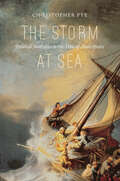- Table View
- List View
Stephen Sondheim and the Reinvention of the American Musical
by Robert L. McLaughlinFrom West Side Story in 1957 to Road Show in 2008, the musicals of Stephen Sondheim (1930–2021) and his collaborators have challenged the conventions of American musical theater and expanded the possibilities of what musical plays can do, how they work, and what they mean. Sondheim's brilliant array of work, including such musicals as Company, Follies, Sweeney Todd, Sunday in the Park with George, and Into the Woods, established him as the preeminent composer/lyricist of his, if not all, time. Stephen Sondheim and the Reinvention of the American Musical places Sondheim's work in two contexts: the exhaustion of the musical play and the postmodernism that, by the 1960s, deeply influenced all the American arts. Sondheim's musicals are central to the transition from the Rodgers and Hammerstein-style musical that had dominated Broadway stages for twenty years to a new postmodern musical. This new style reclaimed many of the self-aware, performative techniques of the 1930s musical comedy to develop its themes of the breakdown of narrative knowledge and the fragmentation of identity. In his most recent work, Sondheim, who was famously mentored by Oscar Hammerstein II, stretches toward a twenty-first-century musical that seeks to break out of the self-referring web of language. Stephen Sondheim and the Reinvention of the American Musical offers close readings of all of Sondheim's musicals and finds in them critiques of the operation of power, questioning of conventional systems of knowledge, and explorations of contemporary identity.
Stepping Stones (Routledge Icarus Ser.)
by Ingemar LindhStepping Stones is the book of a practitioner. It documents the work of a laboratory-based practice that investigated the principles of collective improvisation as a performance practice.
Stick With Me
by Jennifer BlecherAn ice skater without a rink. An artist without a place to draw. Two misfit girls who become unlikely friends over the course of an unusual week. Readers of Lynda Mullaly Hunt, Rebecca Stead, and Lisa Graff will adore Stick with Me.Izzy’s best friend seems to be ditching her for the Queen of Mean, Daphne Toll. Izzy wants to fit in and have some real friends, but all she really has are her drawings. And then her family rents out their house during winter break for some extra cash—and that family’s daughter is sleeping in Izzy’s room and attending the same camp!Wren is focused on perfecting her ice-skating routine after tanking at sectionals last year. But when her sister qualifies for a life-changing treatment for her epilepsy, Wren is carted off to stay in a rented home near Boston. It doesn’t help that she’s forced to attend the local theater camp, where it seems like the mean girls have it out for her.Will Izzy and Wren’s shared status as targets of Phoebe and Daphne bring them closer? Or will middle school drama prevent them from ever becoming friends?Jennifer Blecher, the author of the acclaimed Out of Place, writes with a pitch-perfect ear for tween girls about the ups and downs of middle school friendships. Told from dual perspectives, Stick with Me is a story about fitting in and figuring yourself out.
Stigmas of the Tamil Stage: An Ethnography of Special Drama Artists in South India
by Susan SeizerA study of the lives of popular theater artists, Stigmas of the Tamil Stage is the first in-depth analysis of Special Drama, a genre of performance unique to the southernmost Indian state of Tamilnadu. Held in towns and villages throughout the region, Special Drama performances last from 10 p. m. until dawn. There are no theatrical troupes in Special Drama; individual artists are contracted "specially" for each event. The first two hours of each performance are filled with the kind of bawdy, improvisational comedy that is the primary focus of this study; the remaining hours present more markedly staid dramatic treatments of myth and history. Special Drama artists themselves are of all ages, castes, and ethnic and religious affiliations; the one common denominator in their lives is their lower-class status. Artists regularly speak of how poverty compelled their entrance into the field. Special Drama is looked down upon by the middle- and upper-classes as too popular, too vulgar, and too "mixed. " The artists are stigmatized: people insult them in public and landlords refuse to rent to them. Stigma falls most heavily, however, on actresses, who are marked as "public women" by their participation in Special Drama. As Susan Seizer's sensitive study shows, one of the primary ways the performers deal with such stigma is through humor and linguistic play. Their comedic performances in particular directly address questions of class, culture, and gender deviations--the very issues that so stigmatize them. Seizer draws on extensive interviews with performers, sponsors, audience members, and drama agents as well as on careful readings of live Special Drama performances in considering the complexities of performers' lives both on stage and off.
Still
by Marsha Norman Jen SilvermanIn this darkly comic exploration of loss, intimacy, and motherhood, three women are joined by a baby who never lived. Morgan, in her middle years, is the grieving mother of a stillborn child. Elena, the failed midwife, burdened by guilt, is considering a career change. Dolores, eighteen, is pregnant with a baby she does not want. Meanwhile, Constantinople, the child who wasn't meant to be, wanders lost in search of his mother, trying to make sense of the world while making an unlikely appearance in each woman's personal drama. Poignant, lyrical, ingeniously absurd, and outrageously funny, Jen Silverman's Still is a brave and remarkable exploration of grief and family. It is the seventh winner of the DC Horn Foundation/Yale Drama Series Prize, selected this year by Marsha Norman, the Pulitzer Prize-winning author of Getting Out; 'night, Mother; and other acclaimed theatrical works.
Still Here: The Madcap, Nervy, Singular Life of Elaine Stritch
by Alexandra JacobsA New Yorker Favorite Nonfiction Book of the Year: A “genuinely irresistible” biography of Broadway legend Elaine Stritch (Buffalo News).A New York Times Book Review Editors’ ChoiceStill Here is the first full telling of Elaine Stritch’s life. Rollicking but intimate, it tracks one of Broadway’s great personalities from her upbringing in Detroit during the Great Depression to her fateful move to New York City, where she studied alongside Marlon Brando, Bea Arthur, and Harry Belafonte. We accompany Elaine through her jagged rise to fame, to Hollywood and London, and across her later years, when she enjoyed a stunning renaissance, punctuated by a turn on the popular television show 30 Rock. We explore the influential—and often fraught—collaborations she developed with Noël Coward, Tennessee Williams, and above all Stephen Sondheim, as well as her courageous yet flawed attempts to control a serious drinking problem. And we see the entertainer triumphing over personal turmoil with the development of her Tony Award–winning one-woman show, Elaine Stritch at Liberty, which established her as an emblem of spiky independence and Manhattan life for an entirely new generation of admirers.Following years of meticulous research and interviews, Alexandra Jacobs conveys the full force of Stritch’s sardonic wit and brassy charm while acknowledging her many dark complexities—and creates a portrait of a powerful, vulnerable, honest, and humorous star of stage and screen.“Studded with juicy anecdotes.” —The Washington Post“Provides a marvelous trip back in time to a Broadway that’s gone forever . . . compulsively readable.” —The Wall Street Journal“A chronicle of one impossible brilliant actor and the community around her, this biography provides a thoroughly entertaining and vividly drawn picture of show business in the 20th century.” —The New York Times Book ReviewIncludes photographs
Stillness in Motion in the Seventeenth Century Theatre (Routledge Studies in Renaissance Literature and Culture #Vol. 1)
by P.A. SkantzeStillness in Motion in the Seventeenth Century Theatre provides a comprehensive examination of this aesthetic theory. The author investigates this aesthetic history as a form of artistic creation, philosophical investigation, a way of representing and manipulating ideas about gender and a way of acknowledging, reinforcing and making a critique of social values for the still and moving, the permanent and elapsing. The book's analysis covers the entire seventeenth-century with chapters on the work of Ben Jonson, John Milton, the pamphletheatre, Aphra Behn, John Vanbrugh and Jeremy Collier and will be of interest to scholars in the areas of literary and performance studies.
Stitches
by Glen HuserTravis has been waiting to get to junior high. When that time finally comes, things are both better, and worse, than he had hoped. On the plus side are two great new teachers. On the minus side there's Shon Docker, Travis's old tormenter from elementary school. Travis lives in a trailer park outside a small prairie town. His mother, a country-and-western singer, is on the road a lot; his father is long gone. When things get crazy at his house, he can always visit his best friend, Chantelle, a smart disabled girl with several wild biker brothers. Travis knows he's different. He loves to sew and play with puppets. He wants to become a professional puppeteer. It all makes him a target for Shon and his friends. As Travis and his friends happily prepare a puppet production of A Midsummer Night's Dream for the school graduation festivities, Shon's anger and prejudice erupt in violence.
Stitching La Mode: Patterns and Dressmaking from Fashion Plates of 1785-1795
by Carolyn DowdellStitching La Mode: Patterns and Dressmaking from Fashion Plates of 1785-1795 brings to life women’s unique and extravagant fashions of 1785-1795 in a beautifully illustrated and accessible way. The book consists of scaled patterns directly based on original French, German and English fashion plates drafted according to period-accurate shapes. The patterns encompass the full look presented in each fashion plate from garments to accessories. These are accompanied by a color image of the corresponding fashion plate, straightforward, illustrated directions for recreating the outfits, information on the material used and modelled reproductions of each plate to demonstrate what they would look like in "real life". The book focuses on unique styles often seen in fashion plates but rarely – if ever – patterned before, making this a fresh and exciting yet historically accurate take on late eighteenth-century fashion. Stitching La Mode significantly expands the understanding of transitional fashions from the late eighteenth century with concrete, physical examples of styles, perfectly suited for costume technicians and makers, costume historians and hobby costumers and re-enactors.
Stocism as Performance in Much Ado about Nothing: Acting Indifferently (Elements in Shakespeare Performance)
by Donovan ShermanThis Element demonstrates how Shakespeare's Much Ado about Nothing models an understanding of the philosophy of Stoicism as performance, rather than as intellectual doctrine. To do this, it explores how, despite many early modern cultural institutions' suppression of Stoicism's theatrical capacity, a performative understanding lived on in one of the most influential texts of the era, Baldassare Castiglione's The Book of the Courtier, and that this performativity was itself inherited from one of Castiglione's sources, Cicero's De Oratore. The books concludes with a sustained reading of Much Ado to demonstrate how the play, in performance, itself acts as a Stoic exercise.
Stolen Time: Black Fad Performance and the Calypso Craze
by Shane VogelIn 1956 Harry Belafonte’s Calypso became the first LP to sell more than a million copies. For a few fleeting months, calypso music was the top-selling genre in the US—it even threatened to supplant rock and roll. Stolen Time provides a vivid cultural history of this moment and outlines a new framework—black fad performance—for understanding race, performance, and mass culture in the twentieth century United States. Vogel situates the calypso craze within a cycle of cultural appropriation, including the ragtime craze of 1890s and the Negro vogue of the 1920s, that encapsulates the culture of the Jim Crow era. He follows the fad as it moves defiantly away from any attempt at authenticity and shamelessly embraces calypso kitsch. Although white calypso performers were indeed complicit in a kind of imperialist theft of Trinidadian music and dance, Vogel argues, black calypso craze performers enacted a different, and subtly subversive, kind of theft. They appropriated not Caribbean culture itself, but the US version of it—and in so doing, they mocked American notions of racial authenticity. From musical recordings, nightclub acts, and television broadcasts to Broadway musicals, film, and modern dance, he shows how performers seized the ephemeral opportunities of the fad to comment on black cultural history and even question the meaning of race itself.
Stone Cold Dead Serious: And Other Plays
by Adam RappA collection of plays from Pulitzer Prize finalist Adam Rapp, "one of the more daring young stylists working today" (Time Out New York)Adam Rapp's plays have captivated audiences across the country with their unflinching explorations of the good, the bad, and the ugly in America's heartland and cities. Gathered here are three of his works: Faster, in which two young grifters try to strike a deal with the devil during the hottest summer on record; Finer Noble Gases, a lament for a band of arrested thirty-year-olds slouching toward adulthood amid East Village decay; and the Off-Broadway hit Stone Cold Dead Serious. An honest, strange, and humorous look at a blue-collar family struggling to survive in the face of disability and addiction, and the seemingly surreal lengths their teenage son will go to save them from themselves."Rapp is very gifted, and, even rarer, he has something to say . . . Stone Cold Dead Serious [is] brave, compassionate, and . . . breathtakingly moving." -(New York Times)
Stone the Crows
by David L. PatersonDrama / 2m, 1f / Interior / Lydia Johansen is teetering between a collapsing marriage and self destruction when a new man arrives on her doorstep. This stranger is her husband's long distant brother and a self proclaimed professional drifter. He claims to be passing through on his way to Alaska. Charmed by his self deprecating humor and easy going existence, Lydia attempts to seduce him. Within a twenty four hour period, the bonds of marriage, family and friendship are challenged to the breaking point while secrets better left buried are revealed.
The Stonemason: A Play in Five Acts
by Cormac MccarthyBen Telfair has given up his education to apprentice himself to his grandfather, a man who knows that true masonry is not held together by cement but by the warp of the world.
Stop the Show!: A History of Insane Incidents and Absurd Accidents in the Theater
by Brad SchreiberStop the Show! is the first book to assemble humorous, frightening and bizarre anecdotes about the history of all that went wrong during live theatrical productions in the U.S. and the United Kingdom. It is the publishing equivalent of TV bloopers for the legitimate stage. This book includes stories from top directors, actors, playwrights and technicians from New York, Los Angeles, and points in between, to the United Kingdom, from the 19th century to today. There are stories about missed entrances and exits, onstage unscripted fights between performers, improvised lines, accidental pratfalls, falling scenery, and costume, lighting and makeup screwups. The backstage provides sordid tales of practical jokes, treachery, misplaced props, wild arguments, and generally the kinds of things Michael Frayn created for his farce about a theatrical disaster, Noises Off. This book doesn't leave out the theatergoers either, who snore, fight with each other, talk back to the performers, search for their seats, become suddenly ill, eat, drink, make merry, and are yelled at by the performers - all of which sometimes prompts the show to stop, even though we've always been told it must go on.
Stoppard's Theatre: Finding Order amid Chaos
by John FlemingWith a thirty-year run of award-winning, critically acclaimed, and commercially successful plays, from Rosencrantz and Guildenstern Are Dead (1967) to The Invention of Love (1997), Tom Stoppard is arguably the preeminent playwright in Britain today. His popularity also extends to the United States, where his plays have won three Tony awards and his screenplay for Shakespeare in Love won the 1998 Academy Award for Best Original Screenplay.<P><P>John Fleming offers the first book-length assessment of Stoppard's work in nearly a decade. He takes an in-depth look at the three newest plays (Arcadia, Indian Ink, and The Invention of Love) and the recently revised versions of Travesties and Hapgood, as well as at four other major plays (Rosencrantz, Jumpers, Night and Day, and The Real Thing). Drawing on Stoppard's personal papers at the University of Texas Harry Ransom Humanities Research Center (HRHRC), Fleming also examines Stoppard's previously unknown play Galileo, as well as numerous unpublished scripts and variant texts of his published plays.
Storefront Church
by John Patrick Shanley"Some of Shanley's sharpest comic writing in years... His intense engagement with questions of religion and ethics remains distinctive and invigorating." - Charles Isherwood, New York Times"There's a deeper philosophical vein that the author mines, allowing his language to acquire the heft and timbre of a serious moral debate...We taste bitterness, but also much that is sweet." - David Cote, TimeOut New York"A postmodern morality play that's as funny as it is bracing." - Karen D'Souza, San Jose Mercury NewsConcluding the "Church and State" trilogy of plays that began with Doubt and Defiance, Storefront Church tells the story of a Bronx Borough President who is forced by the mortgage crisis into a confrontation with a local minister. Blending earthy humor and philosophical reflection, this compassionate morality tale is an exploration of the often thorny relationship between spiritual experience and social action.John Patrick Shanley is the author of Doubt: A Parable (Pulitzer Prize for Drama, Tony Award for Best Play), Outside Mullingar (Tony nomination for Best Play), Defiance, Danny and the Deep Blue Sea and Dirty Story, among many other plays. He wrote the teleplay for Live from Baghdad (Emmy nomination for Outstanding Writing of a Miniseries, Movie or Dramatic Special) and the screenplays for Congo, Alive, Five Corners, Joe Versus the Volcano, Doubt (Academy Award nomination for Best Adapted Screenplay) and Moonstruck (Academy Award for Best Original Screenplay).
Stories About the Old Days
by Bill HarrisA former blues singer living in a decaying church in Detroit never ventures out into the world that rejected him. While playing checkers he and Ivy, one the last members of the congregation, move from animosity to friendship. Both have secrets from the old days: he conceals his struggle of faith and despair and she withholds a searing loss as they rescue each other from emotional numbness and terminal loneliness. This wonderful play with superb roles for older Black actors was produced to acclaim in New York at the Henry Street Settlement.
Stories From Shakespeare
by Anna ClaybournePresents prose retellings of ten of Shakespeare’s plays, and includes summaries and main character lists for his other plays.
Stories I Ain't Told Nobody Yet
by Jo CarsonFifty-four monologues and dialogues, a remarkable distillation of rhythms and nuances from the region of the heart.
The Storm at Sea: Political Aesthetics in the Time of Shakespeare
by Christopher PyeThe Storm at Sea: Political Aesthetics in the Time of Shakespeare counters a tradition of cultural analysis that judges considerations of aesthetic autonomy in the early modern context to be either anachronistic or an index of political disengagement. Pye argues that for a post-theocratic era in which the mise-en-forme of the social domain itself was for the first time at stake, the problem of the aesthetic lay at the very core of the political; it is precisely through its engagement with the question of aesthetic autonomy that early modern works most profoundly explore their relation to matters of law, state, sovereignty, and political subjectivity.Pye establishes the significance of a “creationist” political aesthetic—at once a discrete historical category and a phenomenon that troubles our familiar forms of historical accounting—and suggests that the fate of such an aesthetic is intimately bound up with the emergence of modern conceptions of the political sphere.The Storm at Sea moves historically from Leonardo da Vinci to Thomas Hobbes; it focuses on Shakespeare and English drama, with chapters on Hamlet, Othello, A Winter’s Tale, and The Tempest, as well as sustained readings of As You Like It, King Lear, Thomas Kyd’s Spanish Tragedy, and Christopher Marlowe’s Doctor Faustus. Engaging political thinkers such as Carl Schmitt, Giorgio Agamben, Claude Lefort, and Roberto Esposito, The Storm at Sea will be of interest to political theorists as well as to students of literary and visual theory.
Storm is Breaking
by Jim DamicoComedy / 1 m., 1 f. (off stage), 1 boy / Ext. / Winner of the first National Collegiate Playwriting Contest, this is a portrait of a boy who has been following an ant along the sidewalk for several hours. It is a picture that is hard to put out of your mind, and its intimations leave lasting thoughts. The boy prevents a man from stepping on the bug-- insect, the boy corrects him. For to the boy, everything on earth has size and significance.
Storm Warning
by Norm FosterSet in cottage country in 1953, Jack Forrester, a damaged World War II vet, has retreated from life. Then one weekend he meets Emma Currie, an amphetamine-popping chart writer for a big band. Both lives will change forever as these two opposites collide.
The Story of Edgar Sawtelle: A Novel
by David WroblewskiAn Oprah's Book Club Pick#1 New York Times Bestseller“A mystery, a thriller, a ghost story, and a literary tour de force . . . an authentic epic, long and lush, full of back story and observed detail . . . the author exercises a certain magic that catches and holds our attention, a magic that is undeniably his own.”—Los Angeles Times Book ReviewBorn mute, speaking only in sign, Edgar Sawtelle leads an idyllic life on his family’s farm in remote northern Wisconsin, where they raise and train an extraordinary breed of dog. But when tragedy mysteriously strikes, Edgar is forced to flee into the vast neighboring wilderness, accompanied by three yearling dogs. He comes of age in the wild, struggling for survival, until the day Edgar is forced to choose between leaving forever and returning home to learn the truth behind what has happened.Filled with breathtaking scenes—the elemental north woods, the sweep of seasons, an iconic American barn, a fateful vision rendered in the falling rain—The Story of Edgar Sawtelle is a meditation on the limits of language and what lies beyond, a brilliantly inventive retelling of an ancient story, and an epic tale of devotion, betrayal, and courage in the American heartland.
The Story of Lin-Manuel Miranda: An Inspiring Biography for Young Readers (The Story of Biographies)
by Frank BerriosDiscover the life of Lin-Manuel Miranda—a story about creating change through art, for kids ages 6 to 9 Lin-Manuel Miranda is an award-winning composer, actor, and playwright—best known for the hit musical Hamilton, which he created! Before he changed the world of entertainment, Lin-Manuel was an intelligent young boy who loved music and musicals. He was inspired to write his own songs and plays, and his life changed when the plays he wrote became huge successes on Broadway. This book explores how Lin-Manuel went from being an artistic boy growing up in New York City to a rising star and Pulitzer Prize winner.Independent reading—This Lin-Manuel Miranda biography is broken down into short chapters and simple language so kids 6 to 9 can read and learn on their own.Critical thinking—Kids will learn the Who, What, Where, When, Why, and How of Lin-Manuel's life, find definitions of new words, discussion questions, and more.A lasting legacy—Discover how Lin-Manuel has transformed the performing arts and brought Broadway plays to a wider audience.How will Lin-Manuel's dedication to his art and activism inspire you?Discover activists, artists, athletes, and more from across history with the rest of the Story Of series, including famous figures like: Selena Quintanilla, Frida Kahlo, Stan Lee, Maya Angelou, and Audrey Hepburn.
